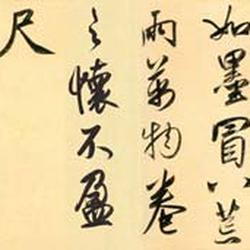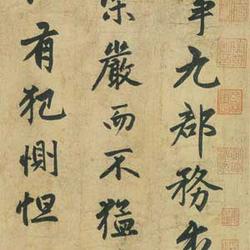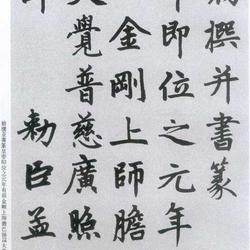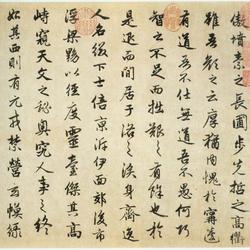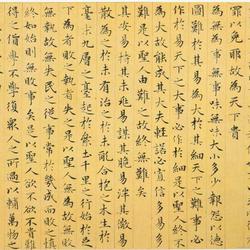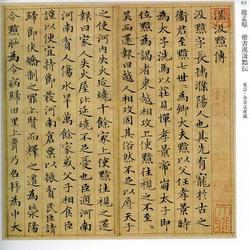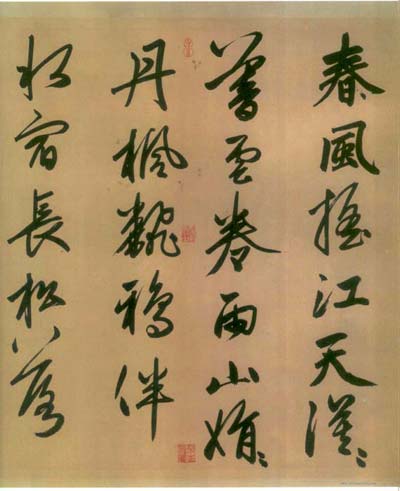
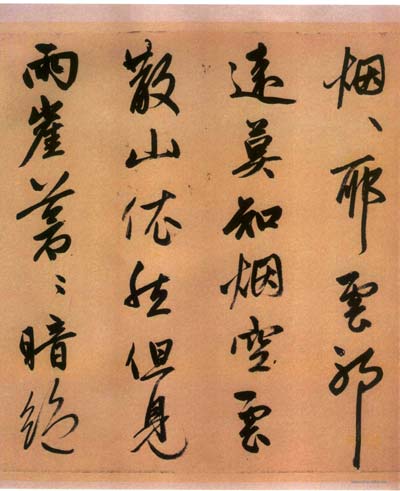
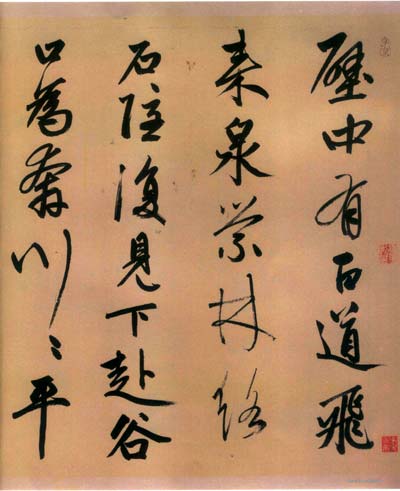
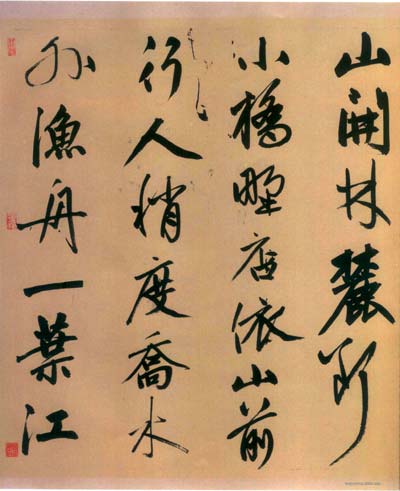
"Poetry Scroll on the Mountains on the Yanjiang River" (detail), paper, running script, 49.8cm in length and 413.9cm in width. Collection of Liaoning Provincial Museum
Youjun was praised by Song Xue as "the contribution of hundreds of schools of thought and the excellence of many styles", while Zhao Mengfu inherited the lineage of the two kings and became the master of calligraphy in the Yuan Dynasty, thus opening a new page in the history of calligraphy. Yu Ji of the Yuan Dynasty once said: "Zhao Songxue's calligraphy is both fluent in writing and profound in learning. When I look at his calligraphy, I can write it with ease and understanding. His regular calligraphy is so good that "Luo Shen Fu" is his standard, and his running script is "Shengjiao Preface". Entering his room, as for the cursive script, he read the "Seventeen Posts" and changed its shape. It can be said that the calligraphy combines academic ability, talent, and mysticism and is unattainable." (Volume 16 of "Shizhantang Calligraphy and Painting Collection") Zhao Mengfu learned from many artists and refined his own style. Mr. Huang Dun believes that his calligraphy style fully matured around the age of forty. Some people also believe that it was not until the fifth year of Dade (1301) to the third year of Dade (1310) that he began to form his own calligraphy characteristics. This latter statement seems a little too late. Because the Chibi Fu in the fifth year of Dade and the Wuxing Fu in the sixth year all have various signs of Zhao Shu's mature period, and his "Rebuilding the Three Gates of Xuanmiao Temple" in regular script is also in the mature Zhao style. "Poetry Scroll of the Overlapping Mountains of the Yanjiang River" in the Liaoning Provincial Museum, last dated. But this work should undoubtedly be from a mature period.
1. About the writing time of the poem "Yanjiang Mountains"
"Poetry Volume of the Picture of the Mountains of the Smoke River" is copied from Su Dongpo's "Picture of the Pictures of the Mountains of the Smoke River Collected by Wang Dingguo" - the first seven ancient poems. "The Picture of Mountains of the Mountains of the Smoke River" was originally written by Wang Shen (1037-1093; or 1048-1104). Wang Shen, courtesy name Jin Qing, was married to the eldest princess of Shu, the daughter of Yingzong, and was an official consort and captain. He was good at poetry and painting, especially landscape paintings, and had contacts with Su Shi, Huang Tingjian and Mi Fu. After he made this picture, there was a poem title on Dongpo. This poem uses poetic language to show the scene of the picture, and also implies the thought of returning to the field. Because Dongpo's poem is so wonderful, Wang Shen also wrote a poem with harmony after the inscription of Dongpo's poem. And the picture "Smoke River Overlapping Mountains" also gained fame. Later, Wang Shen made many more pictures of the overlapping peaks of the Yanjiang River with the same title. The handed down "Picture of Mountains on the Smoke River", collected by the Shanghai Museum, on silk, with Song Lian's postscript at the end: "Wang Jinqing painted "Picture on Mountains on the Smoke River" and there are other scattered copies. The layout is different in both wide and narrow. The inner volume has Dongpo's own handwriting. The poet is particularly exquisite. The title of this volume was written by Hui Temple. The cover has entered the Song Dynasty. It is a treasure. Song Lian, a scholar of the Hanlin Academy, knew it." From this, we can know that the original "Smoke River Overlapping Peaks Picture" has Dongpo on it. Original poem. There is still a record in volume 12 of "Shigutang Calligraphy and Painting Collection", as well as the time when Su Shi wrote: "On December 15, the third year of Yuanyou (1088), Zizhan wrote." The Yuan Dynasty was not far from the Song Dynasty. Zhao Mengfu must have had the opportunity to see this picture and Su Shi's poems and postscripts. The third volume of Liu Guan's "Collected Works of Du Daizhi" contains "Song of the Old Man with Pine Snow before Wang Jinqing's "Picture of Mountains on the Yanjiang River"", which shows the fact that Zhao Mengfu was already old when he visited Wang Shen's painting.
Yan Song of the Ming Dynasty once collected Wang Shen's "Smoke River Peaks Picture". After Yan Song's death, the picture was purchased by Wang Shizhen. Wang's postscript said: "...However, there are two copies of this painting by Jin Qing. The one who practiced it is Wang Ding's national painting and the one who composed the song is Changgong. When Xuanzheng asked the emperor to ask the world to cut off the official documents and ink ink, should the original copy be preserved? The song is at the back, and the seal of the secret palace is at the head of the painting. Only the ink mark of Gong is left in the original copy of Gai Dingguo, but the painting has been lost. In the imperial collection of Jin Qing's special edition, there are also pictures of mountains and rivers far away and mountains and rivers thousands of miles away. Do you know? Those who have done good deeds in the world will take the concubine and the like as a volume, and create a wonderful show of art? If I thought it would be after Yanjin, I would not dare. The lyrics and the painting are slightly inconsistent. As for the distribution structure, the appearance of the relief is wonderful It is definitely not possible for people in the Southern Song Dynasty to distinguish, but Su Changgong's brushwork is pure and elegant, which is the best in his life, and it is inappropriate to add ephemera." "Shi Gutang Calligraphy and Painting Collection Volume 12) This shows that the painting and the title When the poems are separated, the paintings are lost. Su Shi added another picture. Because Su's poem was inconsistent with the artistic conception of this picture, Su's inscribed poem was simply no longer included. During the Wanli period, Wen Jia wrote a postscript about this picture: "I saw two copies of Wang Jinqing's Yanjiang Mountains. One was in the Wei family in Kunshan, and the other was in the Yao family in Jinling. Neither of them contained Su's poems. After Yao found the book written by Songxue, the scene was wonderful. It is very similar to Su Shi's poems. It has now been returned to the Secret Palace. The Wei style version has the same style, colors and style. This version has a pure and elegant charm, and the splendid calligraphy is very different from other books. It is a treasure. Wanli Ding Chou (157) 7) Xia, Wen Jia's postscript." (Exam 12 of "Shigutang Huikao")
Based on this, it can be affirmed that Zhao Mengfu once wrote a long title of a Su poem to accompany Wang Shen's "The Picture of Mountains on the Smoke River". "Calligraphy and Painting Fang" says: "The picture scroll of the Yanjiang Mountains of Wang Jinqing in the public collection of Yuanmei (Wang Shizhen) has ancient and elegant brushwork and subtle ink halo, which is very much the legacy of the ancients. Later there is a long song of Dongpo. The dripping song is particularly powerful and dazzling. The original It is an old work of Yan Fenyi (i.e. Yan Song), and both calligraphy and painting are excellent. I don’t know if it is more impressive than the old copy of Xu Ke Zhai.” (Volume 12 of Shigutang Calligraphy and Painting Collection). The postscript of Su's poems in Wang Shizhen's collection is probably the inscription by Zhao Mengfu. The size of the map of the Yanjiang Mountains in Shangbo is (45·2X66cm), so the height of Zhao Pei's book title should not be less than this. For Zhao Mengfu, who is used to writing horizontal scrolls (usually only about 20 to 30 centimeters long), this is a big work. The inscription and postscript of Zhao's book now in the Liao Bo collection are 49·8x413.9cm, which is about the same height as the painting core. However, Shen Zhou and Wen Zhengming later repainted this picture, so Zhao Ba of Liaobo received Shen and Wen's drawings instead of Wang Shen's original drawings.
So, when did Zhao Mengfan write the inscriptions and postscripts on Su Shi? It was probably made when he was about fifty years old. The reasons are:
In the seventh year of Dade (1303), Zhao Mengfu once painted a picture of "Chongjiang Overlapping Mountains" with a height of 28.4 centimeters. The composition of this painting is similar to Wang Shen's "Smoke River Overlapping Mountains". Zhao Mengfu may have created it after seeing Wang Shen's painting. This painting does not have an inscription by Zhao, but has an inscription and postscript by Yu Ji: "In the past, the Yangtze River was dangerous, and white hair could be mourned. A hundred years of economy was exhausted, and the painting started in one day. The monks and temples are vaguely there, and the fishing boats are returning in a mighty way. A few trees are in depression, sometimes there are Come to Hainao." The inscription is very large, which matches the grand atmosphere of the painting. Zhao Mengfu himself also had a collection of Wang Shen's "Mountains and Gorges" and had a special liking for Wang Shen's paintings. In 1303, Zhao Mengfu was promoted to Confucianism in Jiangsu, Zhejiang and other places, so he also had the intention of returning to seclusion in his thoughts, which was consistent with Su Shi's poetic meaning. Therefore, it was more in line with his ideological reality that he inscribed Su Shi's poem on Wang Shen's "Smoke River Overlapping Peaks" at this time.
Judging from the style of calligraphy, Zhao Mengfu at this time has fully demonstrated his mature calligraphy style. Representative works such as Chibi Fu and Wu Xing Fu are all skillfully written, with handsome and elegant structures and very natural writing. The style of Zhao Shu in the Liaobo Collection basically belongs to the style characteristics of this period. The writing style is clear and handsome, and the muscles and bones are elegant. The brushstrokes are unrestrained and free-spirited. Therefore, the time when Zhao Mengfu wrote the inscriptions and postscripts of Su's poems should be about the same time as the time when he painted "Chongjiang Overlapping Mountains", that is, when he was fifty years old.
2. The style characteristics and significance of Zhao Mengfu’s poems and postscripts
Zhao Mengfu's poems and postscripts inscribed by Su in the Liao Bo collection are very different from the common Zhao Shu's Wanli and gentle style. Therefore, it is worth sorting out and pursuing the stylistic characteristics of this work.
Zhao Mengfu's early running script has a handsome structure, gentle writing style and graceful posture. This is the result of his long-term copying of the calligraphy style of the "Two Kings". In early running scripts such as "Returning Words" and "Baotu Spring Poems", the pen is plump, the body is flat and wide, the feet are heavy, and the bone strength is relatively weak. By the time of "Luo Shen Fu Volume" in the first year of Dade and "Red Cliff Two Fu" in the fifth year, although the posture is still handsome and the lines are still rounded, the strokes of the pen have been greatly enhanced, so the muscles and bones are stronger and stronger, and some technical skills have improved. More attention to detail. As Mr. Pan Boying pointed out: "For example, the left and right characters in "Lanxu Preface" have a horizontal line at the top and then a left point, and a small circle is turned up at the junction, which is not very obvious in "Lanting Tie". Because he learned it carefully, he specially emphasized on making the circle of the stroke larger." ("A Brief Introduction to Chinese Calligraphy" page 132) The characters "you", "right" and "xiong" all have this feature. In the sixth year of Dade, the writing style of "Wu Xing Fu" became more vigorous and powerful, and the muscles and postures reached new heights. Therefore, the postscript of Zhao Shu's poems in the seventh year of Dade followed this change in calligraphy style. Its style features are as follows: First, the brush strokes are hearty and unrestrained, the horizontal strokes are vigorous, the strokes are sharp, and there are even more exaggerated lines, such as the two vertical strokes of "ye" in the third line, which are not only extremely Have momentum and strong bones. The word "break" in the seventh line occupies the position of several characters, which is extremely rare in Zhao Shu; secondly, the structure develops vertically and is no longer flat and wide. This change in body posture also reflects the change from a soft and charming calligraphy style to a vigorous and vigorous calligraphy style; thirdly, the strengthening of rhythm and intensity also changes the past situation of even weight and weight and weak strokes. Because the paper width is larger than the banners Zhao Mengfu is used to writing, the shape of each character is also very large, as big as a child's fist. Therefore, there are new changes in font size and stroke thickness. The sizes are mixed and vary greatly, and the dry and moist ones alternate, so the rhythm is strong. There is an unrestrained and enthusiastic rhythm in the whole painting. There are seven characters in the first line and only four characters in the third line. There are many dry pens entangled in it, which is green and powerful, so it has the joy of calmness. This distance is far removed from the past works, and is similar to "The Scroll of Broken Friendship with Mountain Juyuan" written in his very late years. Because of these characteristics of Zhao Shu, we can see another aspect of Zhao Mengfu's calligraphy. <
In the eyes of ordinary people, Zhao Mengfu is a weakling with weak integrity, and his character is to be submissive. In fact, Zhao is also a straightforward person. He has a poem that says: "My nature is true and forthright, and I don't know how to be angry and angry. I want to follow the customs, and I share the hardships in Xia Qi." (Volume 3 of "Songxue Collected Works") Xu Fuguan said: "Zhao Songxue's spiritual purity comes from him. He is a reclusive character who lives in wealth but has a heart in the world." ("Chinese Art Spirit" p. 384) He also said: ""Chongjiang Mountains" is a famous painting of pine trees and snow. Wang Shizhen said that it is "simple and distant, and the meaning of the painting is Outside.' But Yu Ji's poem is: 'In the past, the danger of the Yangtze River made people grieve with white hair. A century's worth of economy was exhausted, and a day's drawing began.' Yu Ji can truly understand Zhao Songxue; and he can also appreciate this picture scroll. The lofty value of Dan Jian Yuan. But he knew better that behind this kind of digression about Jian Yuan, there was an author of "White Hair Sadness". After that, Shen Zhou, a great painter of the Ming Dynasty, could also say, "Is it still from the beginning?" Seeing the old things in dismal condition, it seems that there are tears and lonely loyalty." (ibid., page 379) This passage provides a thorough analysis of why Zhao Mengfu painted "Chongjiang Overlapping Mountains" and the sense of seclusion he placed in the painting. think. Zhao Mengfu's thoughts and character are complex, but his copying of Dongpo's poems and his paintings by Wang Jinqing embody his true temperament. His paintings are simple and distant, and his inscriptions and postscripts are also casual and unrestrained, simple and distant. Therefore, this work of Zhao Mengfu is indeed a rare masterpiece. It not only allows us to see the diversity and style changes of Zhao Shu, but also the sincere side of Zhao Mengfu's character.
3. Is the Liaobo version authentic or filled in?
Wang Jinqing's "Picture of Overlapping Mountains on the Smoke River" has been circulated in confusion due to the many versions. According to Volume 13 of "Xuanhe Painting Book", it was once collected by the Imperial Household. Collected by the Inner Palace, they are unified and framed according to the "Shaoxing decoration". Before reinstallation, all old traces such as the inscriptions, inscriptions, and seals of the predecessors were cut off. Therefore, Dongpo's inscriptions and postscripts were among the first to be cut. This resulted in the separation of painting and title. And because Wang Jinqing painted many paintings with the same title, there were more mixed paintings in the future. There are three or four types of "Smoke River Overlapping Mountains" recorded in "Shigutang Calligraphy and Painting Collection" alone. Su's poems and postscripts are from the third and fourth years of Yuanyou, indicating that fake inscriptions and postscripts are also mixed in. The title of Zhao Mengfu's poem was once included in Yao's original picture. However, the title of the picture was later divided, so there are records of Shen Zhou and Wen Zhengming redrawing the picture. It is unknown when Zhao Ba was separated from the painting. There are many copies of Zhao Mengfu's calligraphy, so whether Liaobo's calligraphy is the authentic one has been questioned in the past. The title of the volume has the words "The best faker with double hooks", which is the result of Qianlong's appraisal. The author took a closer look at the Liaobo edition and felt that it should be a check-and-fill edition for the following reasons:
(1) There are many strokes but not everywhere. Zhao Mengfu was about fifty years old when he inscribed the "Picture of Mountains on the Smoke River", and he was absolutely proficient in using the pen. However, some of the pens used in the Liaobo edition have obvious shortcomings. For example, among the two words "No" in the poem, the horizontal strokes of the former "I don't know" "No" are heavily pressed and lightly lifted, which is extremely uneven; the horizontal strokes of the latter "missing" "No" are drawn too fast and the middle section is too thin. , these two horizontal strokes of "one" both have the disease of empty space in the middle, and are by no means similar to the character "no" in Zhao Shu. (You can refer to the word "bu" in "Wu Xing Fu" from the same period. There are many similar situations. For example, in "Yi Ya Ye in the Fishing Boat": "一", the pen is not closed, which is incredible. The left part of "floating" in the second line is also It's very stiff, not like Zhao's brush. The horizontal brush for the word "世" in "人世" is definitely a failure.
(2) Neglect of certain writing details. For example, among the three characters "you" in the poem, the circle of "fanbi" in the Liao version is too large, connecting the first and second strokes into one stroke, which is not in line with Zhao Shu's writing habits. (Although there are some connected ones in Zhao's book, there are not many.) Zhao Mengfu paid great attention to the details of this kind of writing. The last "right" in the Liaobo version is slightly similar. Another example is the use of the words "human" and "heaven", which are too exaggerated and are no longer in line with Zhao Shu's situation when he was fifty years old.
(3) The stroke order of some characters is also different from that in Zhao Shu. For example, the stroke order of the Liaobo version of "bi" is different from that of the Zhao book (such as "Wuxing Fu Juan"). The higher point of the Liao version is the last stroke. And Zhao Shu must place the "dot" first, and the two "dots" on the left and right must be symmetrical. This is inimitable.
However, even if it is a filled-in version, the Liaobo version still has great cultural relic and artistic value. Because its appearance is generally good, the level of the hooker is not low, and there are still some reports of Zhao Shufengshen.

